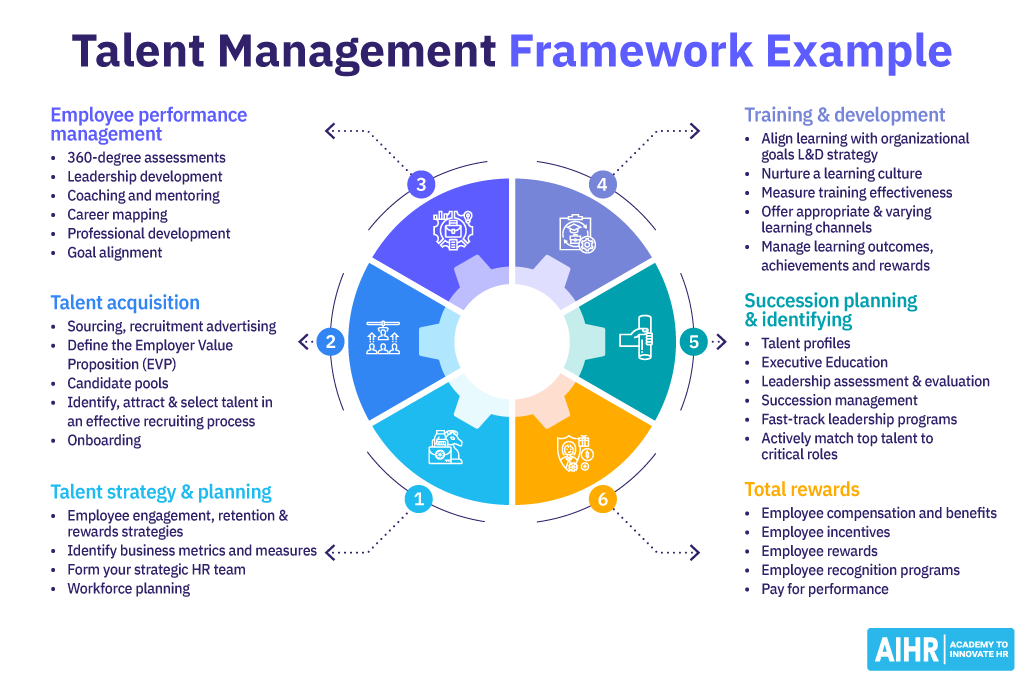Key Takeaways
- Talent development involves continuous learning and adaptation in the workplace.
- Effective strategies focus on both individual and organizational goals.
- Incorporating technology can enhance training and development success.
- Real-life examples demonstrate the impact of solid talent development strategies.
An effective talent development strategy for today’s workforce focuses on aligning employee growth with organizational goals. It identifies skill gaps and future needs and provides tailored training and development programs. Emphasizing continuous learning, mentorship, and clear growth paths keeps employees engaged and motivated. Regular feedback mechanisms and performance evaluations ensure the strategy adapts to evolving business and employee demands. By fostering a culture of learning and advancement, companies can enhance employee satisfaction and retention, boost productivity, and strengthen organizational resilience. This approach supports individual career goals and drives overall business success in a competitive landscape.
Importance of Talent Development
In an era where competition and rapid technological advancement shape industries, a robust strategy for talent development is crucial. It facilitates not only individual growth but also propels organizational success. As businesses strive to innovate, cultivating a workforce capable of adapting to new challenges is indispensable. This does not solely concern skill acquisition but also fostering a mindset that embraces change, values continuous learning, and enhances personal and professional growth.
Recent studies show that companies with solid development frameworks outperform their competition and boast higher employee satisfaction and retention rates. Employees value growth opportunities, as these are perceived as investments in their future. When given the tools to succeed, they are more engaged and productive, which fuels company performance and sustains competitive advantage in the marketplace.
Critical Elements of an Effective Strategy
Several key elements contribute to a successful talent development plan. Firstly, it should align with organizational goals while addressing the individual aspirations of employees. This involves clear communication of the company’s strategic objectives and how personal professional development can support those objectives. Customized learning opportunities—tailored to specific roles and career paths—are especially effective. These may include formal training programs, mentoring schemes, and on-the-job experiences reinforcing learning and application. Continuous assessment and feedback ensure that employees remain on the right trajectory, allowing for necessary adjustments to maximize personal and organizational benefit.
Technology in Talent Development
Integrating technology can vastly enhance the reach and efficiency of development initiatives. Modern e-learning platforms offer flexibility, enabling employees to access training materials anytime. These tools facilitate not just the dissemination of knowledge but also foster collaboration and peer learning. For instance, digital forums and interactive webinars create opportunities for learners to engage, share ideas, and learn from industry experts globally.
Businesses are using AI more and more to personalize learning experiences, according to the Society for Human Resource Management (SHRM). This technology adapts to the user’s pace and learning style, making the process more efficient and impactful. This transition to digital solutions is not just a trend—it’s an integral element shaping the future of talent development and preparing companies for the challenges of tomorrow.
Steps to Build a Successful Strategy
- Identify Goals: Start by clearly defining the organization’s goals. This sets the stage for aligning development initiatives with broader business objectives.
- Assess Current Skills: Conduct a thorough skills gap analysis to understand the current capability landscape and the skills required for future success.
- Create Personalized Plans: Develop learning paths tailored to individual needs, ensuring they are relevant and engaging for the employee.
- Leverage Technology: Implement digital tools to facilitate and track training processes, ensuring accessibility and efficient progress tracking.
- Evaluate and Adjust: Continuously measure the effectiveness of development programs through metrics and feedback, making adjustments to optimize outcomes.
Measuring Success
Assessing talent development programs’ impact involves combining qualitative and quantitative measures. Key metrics—like employee satisfaction, retention, and performance improvements—are critical success indicators. Regular surveys, structured feedback sessions, and comprehensive performance reviews help gauge employees’ perceptions and the effectiveness of development activities in meeting organizational objectives. This approach provides a clear picture of both individual and team progress. By continuously evaluating these insights, organizations can refine their strategies to stay aligned with changing business objectives and workforce needs. Such an iterative process fosters a culture of growth and adaptability, ensuring talent development efforts are impactful and sustainable.
Real-Life Examples
Consider the case of a tech giant that revamped its development strategy to focus on personalized learning experiences. By offering a suite of learning resources tailored to diverse needs and learning preferences, the company boosted employee engagement by 15%. It led to a noticeable increase in innovation output and customer satisfaction scores. This holistic approach to development is a testament to the potential impact of well-structured development strategies on company performance and employee fulfillment.
Common Challenges and Solutions
One significant hurdle in talent development is keeping pace with industry changes. Overcoming this obstacle can be facilitated by establishing a culture of ongoing learning. Providing access to up-to-date and pertinent knowledge and empowering staff members to take charge of their education is essential for quickly adjusting to emerging market trends. Resource limitations can also hinder development initiatives; however, prioritizing strategies that align closely with business objectives is critical to maximizing impact. This requires strategic investment and careful planning to ensure sustainable development efforts yield tangible benefits.
Future Trends
Personalized talent development will become more prominent as the future unfolds, with AI and machine learning playing crucial roles in crafting adaptive learning environments. Additionally, the persistence of remote work will continue to drive advancements in virtual and hybrid training methods, ensuring they are both accessible and practical. Organizations adopting these trends by establishing solid frameworks supporting individual development and organizational success will likely maintain a competitive advantage and open the door for a more competent and agile workforce.
